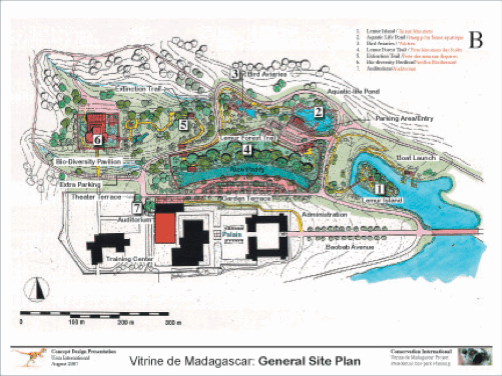Vitrine de Madagascar

The President wants what?...
Conservation International asked Ursa to explore the opportunities to build an Biodiversity Exhibit on the grounds of the Presidential Palace outside of Antananrivo, Madagascar for the current president, Marc Ravalomanana. This complex is a live collection of the rich biodiversity of today’s Madagascar, it’s plants, animals, it’s architectural heritage AND, like nowhere else in the world, it is a display of Madagascar’s unique extinct species taken from the fossil record.
The project is divided into 7 major project areas and covers approximately 17 hectares (42 acres). Most visitors arrive after passing through a new gate before the main gatehouse, and drive along the existing roadway to a new central parking area. From the existing Lemur Island, the Aquatic Life Pond and Bird Aviaries, The visitor follows up the hill through the Lemur forest Trail and into the Extinction Trail to the Biodiversity Pavilion located on the top of the site in the footprint of the old Pagoda, and then down to the new Auditorium. From there guests may rest on the Garden Terraces where final views across the rice paddies to the free ranging lemurs are possible.
Each area presents a different group of species within a natural setting. The animals are contained within large habitats specially designed for their needs with special animal management areas. There are interpretive buildings for each project that represent different architectural styles from different regions of the country.
For the presentation to the President, we built a full-size fiberglass sculpture of one of the Extinct species, Megaladapus Edwardii, that would be found in the trees on the Extinction Trail. A dozen other extinct species will be eventually displayed in a natural context to experience what it would have been like not that long ago, when Giant Sloths, and Koala-like Lemurs inhabited the forest.
The Biodiversity Pavilion is the crowning-jewel of the Park, with 8 major galleries and habitats and include:
1. The Gems of Madagascar exhibit, displaying some of the small, endemic species such as the Parson’s chameleon, the spiny Tenrec, the Mittermeier Mouse Lemur, and Leaf-nosed Snake other unique creatures,
2. The free-flight tropical rainforest bird aviary where visitors can explore a two story sky-lit space, with some of the rainforest birds and chameleons, without visible barriers,
3. The Lemur Gallery, where several family groups of lemurs live in a specially design mesh structure adjacent to the pavilion, viewed through an expansive glass partition,
4. The Biodiversity Hall, where small, ‘jewel-tanks’ display living insect species, such as the Madagascar Cockroach, centipedes, stick insects, leaf insects and other unique Malagasy invertebrate species.
5. The Spiny Desert Conservatory; a re-creation of the dry forests of the south, where truly unique plant species create a harsh environment for a host of endemic species. This walk-through exhibit with a controlled climate and glass roof will be a great introduction a very important habitat.
6. The Garden Terrace; a relaxing outdoor patio where visitors can sit and enjoy a drink or light snack surrounded by various small reptiles overlooking the reptile pool.
7. The Future’s Gallery, an interpretive space that tells the story of Conservation in Madagascar – what is being done to protect the wild habitats and species in one of the most unique countries on Earth.
8. The Fruit Bat Gallery; an exterior exhibit for the endangered fruit bats. The visitors exit the pavilion surrounded by the bats that will roost inches from them.
The scope of the project expanded far beyond the original concept of a Bio-diversity Exhibit, into a small wildlife education and breeding center for Madagascar’s rarest of the rare supported by the head of government - . but due to a change in government., the project is currently shelved.